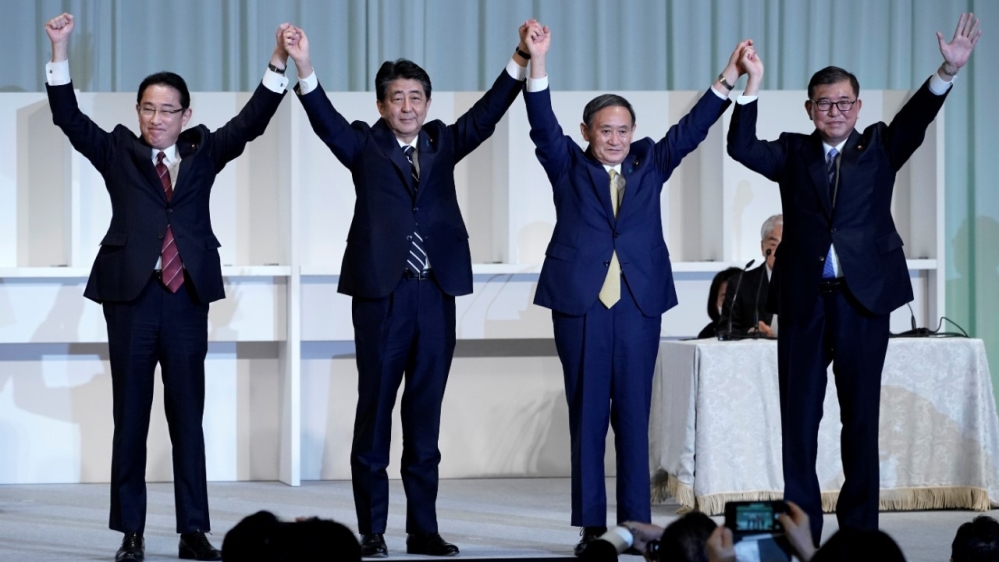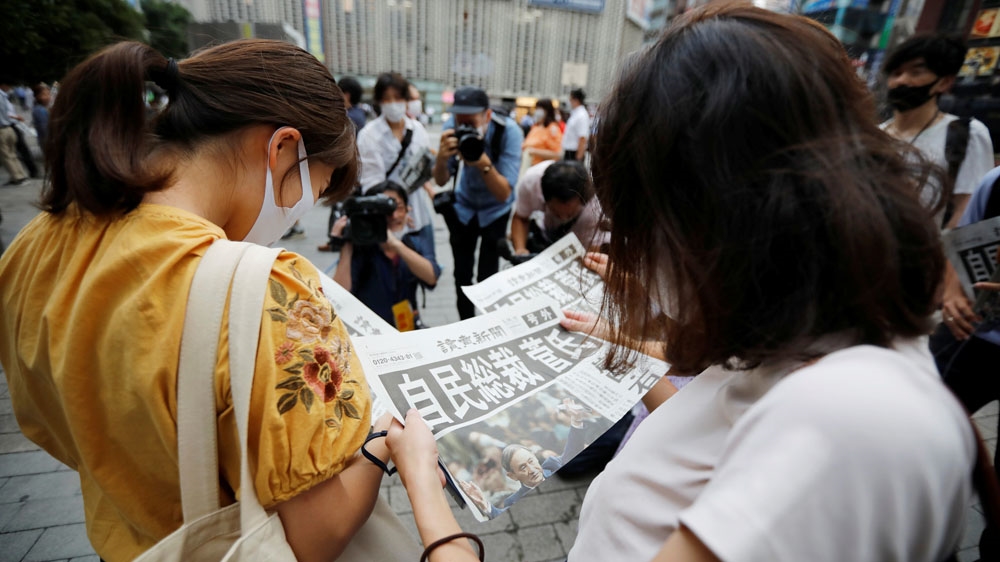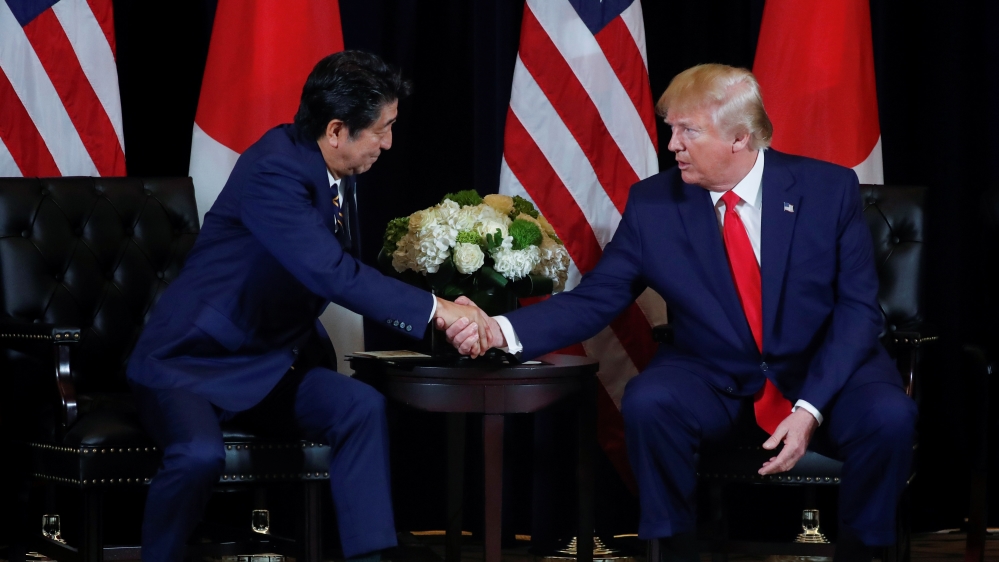Formidable challenges await as Suga set to take over as Japan PM
The 71-year-old will need all his political skills to deal with COVID-19, a ravaged economy and an ageing population.

As Chief Cabinet Secretary, Yoshihide Suga spent nearly eight years as the right-hand man to outgoing Japanese Prime Minister Shinzo Abe.
Now, as Suga prepares to take the country’s top job in an all-but-guaranteed parliamentary vote on Wednesday, he will need to capitalise on his political deal-making skills and his inside knowledge of Japan’s complex bureaucracy to help him address the country’s formidable challenges.
“Nobody has had as long a tenure as Suga,” Kiyoaki Aburaki, managing director of BowerGroup Asia in Tokyo, told Al Jazeera. “He knows everything. He knows how government works. He knows how sectionalism has previously prevented change. That is a great asset for him.”
The 71-year-old son of a strawberry farmer, Suga is set to take over the leadership at a time when Japan’s economy – after years of stagnation and already struggling with the long-term effects of the world’s most elderly population – has been dealt a body blow by COVID-19.
Japan’s caseload may be far smaller than that of many other countries, but the world’s third-largest economy shrank a record 27.8 percent from April to June this year compared with the previous quarter due to pandemic-related lockdowns that were only relaxed in late May.

While the decline has put more pressure on the government to act – it was Japan’s third straight quarter of contraction – an eye-watering level of public debt has left policymakers with less and less room for manoeuvre.
“The fiscal situation is very serious now,” Tsuneo Watanabe, a senior fellow at the Sasakawa Peace Foundation, told Al Jazeera. “Combined with COVID-19, I don’t think any Japanese leader in the future can enjoy the opportunity for such a large stimulus push.”
Abe loyalist
Unlike his predecessors, Suga does not come from a privileged background and rose to the top of the ruling Liberal Democratic Party without belonging to any of its powerful factions.
As the face of the Abe government – helming regular press conferences as its chief spokesman – Suga cut a rather dour figure, but he is expected to push forward with his own initiatives including bureaucratic reform, digitalisation, and helping Japan’s rural communities through policies on agriculture and tourism.
The fight against the coronavirus will be a priority, but he has also signalled a continuation of the broad policy framework of Abenomics, the three-pronged strategy that was Abe’s signature policy and that involved monetary easing, government spending and structural reform.
Those structural reforms were supposed to lessen the impact of Japan’s ageing population by making it easier for women to work, opening the door to migrants and relaxing labour laws. Already, more than a quarter of Japanese are 65 or older, and by 2065, that number will rise to one in three, according to official projections. That means fewer and fewer people of working age and less tax.
|
|
“In order to overcome the crisis and give the Japanese people a sense of relief, we need to succeed in what Prime Minister Abe has been implementing,” Suga said on Monday after winning the LDP leadership contest. “This is my mission.”
The new prime minister will also find challenges on the international stage.
Abe became the face of foreign policy during his time in office – forging an unlikely bond with United States’ President Donald Trump, reaching out to China, Russia and India, and centralising decision-making within the prime minister’s office.
But he also involved Suga, who was appointed to a key role in relation to the US airbases on the southern island of Okinawa and who met US Vice President Mike Pence during a visit to Washington in May last year – a trip that fuelled speculation about his leadership ambitions.
Now a US election looms and the China-US relationship has deteriorated further over issues from trade to events in Hong Kong and the treatment of the mainly Muslim Uighurs.
Election rumours
Adding a further complication, Suga’s term as party leader expires in September 2021 – and Japan must hold an election by October next year.
The LDP, which rules in coalition with Komeito, a smaller party, has enjoyed a two-thirds majority in the House of Representatives, the lower house of the National Diet of Japan, since 2012.

While the ruling party is expected to win any contest, the opposition has already sensed an opportunity to end the LDP’s long-term dominance. A new merged opposition force was announced on Tuesday.
“It’s easy for the opposition to appeal to the people and if the economy is bad, then people will believe it,” said Sasakawa Peace Foundation’s Watanabe. “That’s a big challenge for Suga as it will reduce his majority and maybe some in the party could challenge him.”
There is talk that Suga might opt for a snap poll to take advantage of a recent surge in his popularity, and avoid a clash with the COVID-19 delayed Tokyo Olympics, which are now scheduled for July 2021.
At the back of his mind will be the knowledge that periods of stable leadership in Japan have often been followed by a revolving door of weak and short-lived governments – most recently after the resignation of the popular and charismatic Junichiro Koizumi in 2006.
Koizumi’s departure led first to Abe, who resigned after less than a year in office because of poor health, and eventually to the LDP losing power for only the second time since 1955 to the Democrats. It was only when Abe returned a second time – reportedly on Suga’s urging – that stability was restored.
Suga has said that being outside the party factions is a strength, but it could also prove his weakness. Faction leaders could easily withdraw their support for his leadership if their demands are ignored, and a crop of energetic politicians are waiting in the wings should Suga fail.

The new prime minister will announce his cabinet soon after he takes office on Wednesday, and most ministers from the Abe administration are expected to keep their jobs.
But if Suga wants to maintain his popularity with his party and the public, he might have to show himself to be something more than simply a repackaged Abe.
“If Abe’s time in office suggests anything for those who follow in his footsteps, it is that the Japanese people want stable government, but even more, they want innovative and bold ideas for the way forward,” wrote Sheila Smith, senior fellow for Japan Studies at the Council of Foreign Relations, in an analysis of Japanese politics after Abe. “In the post-Abe era, it will be important to deliver on this need for hope.”